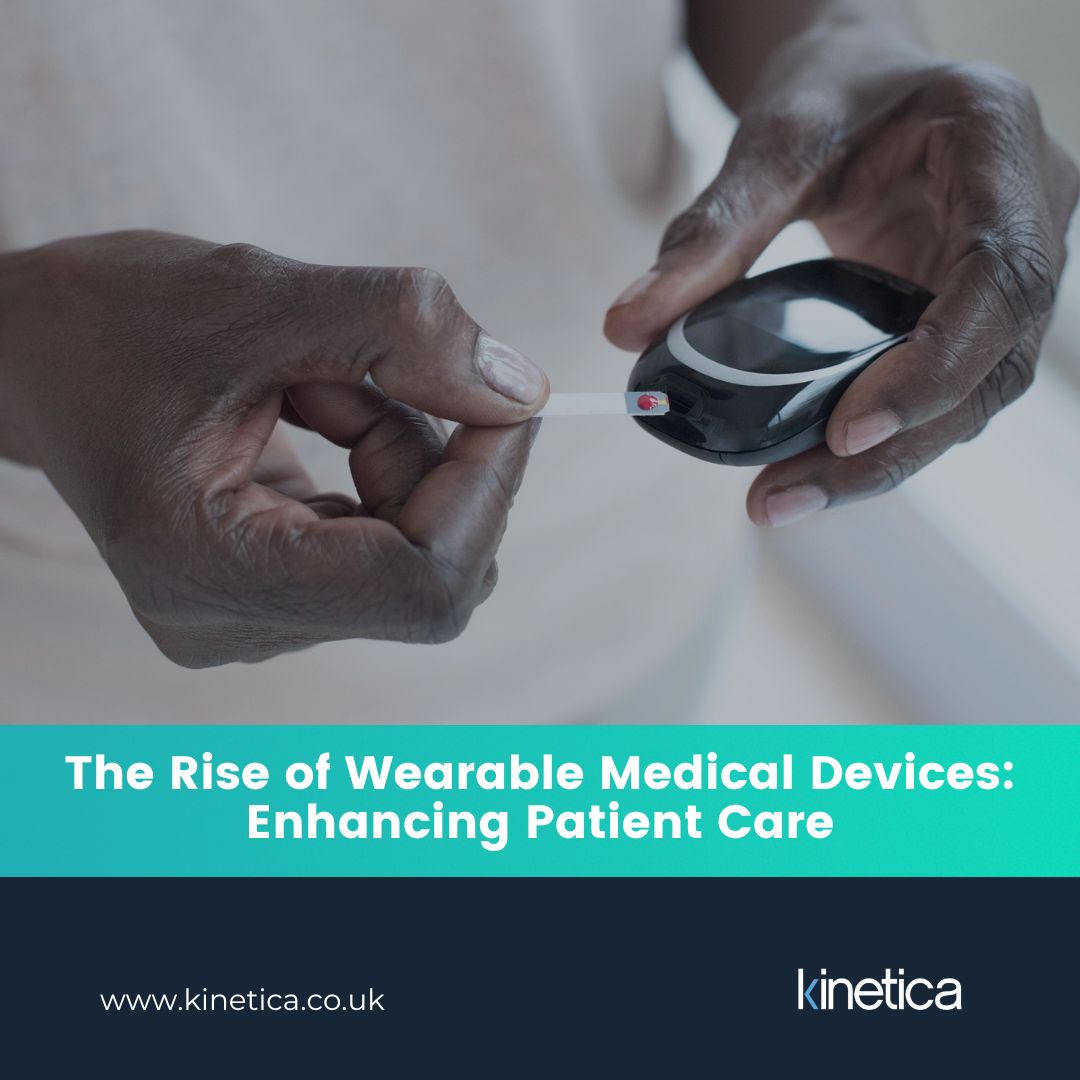INSIGHTS
The latest insights & news from Kinetica
The Rise of Wearable Medical Devices: Enhancing Patient Care
08 Apr, 20245 MinutesAre wearable medical devices truly the game-changer they're often touted to be in enhancing ...

Are wearable medical devices truly the game-changer they're often touted to be in enhancing patient well-being?
In the ever-evolving landscape of healthcare technology, wearable medical devices have emerged as a transformative force, revolutionising the way we monitor and manage health conditions. These innovative devices, ranging from smartwatches to adhesive patches, are not only reshaping patient care but also empowering individuals to take control of their well-being like never before. With advancements in sensor technology, data analytics, and connectivity, wearable medical devices are poised to play a pivotal role in the future of healthcare.
According to projections, the value added in the Medical Devices & Products market is anticipated to reach $6.41bn in 2024, with the number of enterprises in this market is expected to reach 307,000. Despite these promising figures, the number of employees in the Medical Devices & Products market is anticipated to be 66.40k in 2024, with a projected negative compound annual growth rate of 1.91% from 2024 to 2028.
One of the most significant benefits of wearable medical devices is their ability to provide real-time health monitoring. Unlike traditional medical equipment confined to clinical settings, wearables allow patients to continuously track vital signs, activity levels, and other health metrics in their everyday lives. This real-time data enables early detection of health issues, facilitating timely intervention and proactive management of chronic conditions.
For individuals with conditions such as diabetes, heart disease, or hypertension, wearable devices offer a lifeline by alerting them to potential health fluctuations before they escalate into emergencies. By fostering a greater awareness of their health status, patients are empowered to make informed decisions about their lifestyle, medication adherence, and when to seek medical assistance.
One of the key factors driving the adoption of wearable medical devices is their seamless integration into daily life. Unlike bulky medical equipment, these devices are designed to be discreet, comfortable, and user-friendly. Whether worn as a wristband, embedded in clothing, or attached to the skin, wearables blend effortlessly into the wearer's routine, allowing for continuous monitoring without disrupting daily activities.
This integration extends beyond physical comfort to include seamless connectivity with smartphones and other digital platforms. By synchronising with mobile apps or cloud-based platforms, wearable devices enable users to access and share their health data with caregivers, healthcare providers, and electronic health records. This streamlined communication facilitates remote monitoring, telemedicine consultations, and personalised treatment plans, regardless of geographical barriers.
Wearable medical devices are at the forefront of the shift towards personalised healthcare. By capturing vast amounts of data on individual health metrics and behaviour patterns, these devices enable a deeper understanding of each patient's unique needs and challenges. Advanced analytics algorithms can process this data to generate actionable insights, guiding personalised interventions and treatment strategies tailored to the individual.
For example, wearable devices equipped with artificial intelligence algorithms can analyse patterns in heart rate variability to predict the onset of cardiac arrhythmias or identify potential triggers for asthma attacks. By leveraging machine learning and predictive modelling, healthcare providers can anticipate health risks, optimise medication regimens, and empower patients with personalised recommendations for lifestyle modifications.
Despite their immense potential, wearable medical devices still face several challenges and limitations that need to be addressed. Issues such as data privacy, security concerns, and regulatory compliance remain paramount, especially as wearables collect increasingly sensitive health information. Ensuring the accuracy, reliability, and interoperability of these devices across different platforms and healthcare systems is also crucial for widespread adoption and integration into clinical practice.
Furthermore, while wearable devices offer unprecedented opportunities for health monitoring and management, they must be accessible and affordable to all segments of the population. Addressing disparities in access to technology and healthcare services is essential to ensure that wearable devices benefit all patients, regardless of socioeconomic status or geographic location.
The rise of wearable medical devices represents a paradigm shift in patient care, empowering individuals to become active participants in their own health management. By providing real-time monitoring, seamless integration into daily life, and personalised insights, these devices are revolutionising the way we prevent, diagnose, and treat health conditions.
As wearable technology continues to evolve, fuelled by advancements in sensor technology, artificial intelligence, and data analytics, the possibilities for improving patient care are endless. By embracing innovation, collaboration, and patient-centred approaches, we can harness the full potential of wearable medical devices to create a healthier, more connected future for all.
What are your thoughts on the future integration of wearable medical devices into mainstream healthcare practices? How do you envision these devices shaping patient care in the years to come? Share your thoughts in the comments below!
#Kinetica #WearableTech #PatientCare #HealthTech #DigitalHealth #FutureOfMedicine




